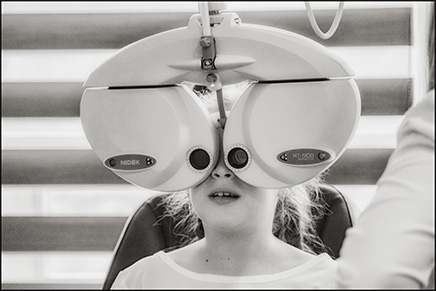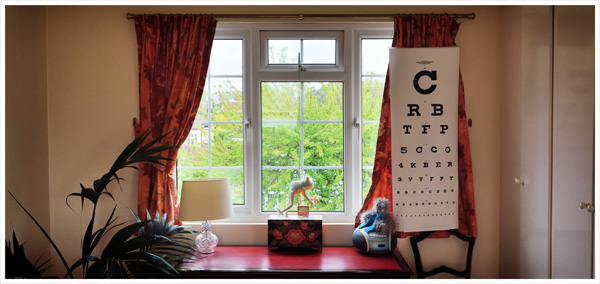Palming
Perhaps the simplest of all the techniques, Palming is also regarded as a foundation for learning how to relax the eyes and mind.
Learn MoreTurn the Eye Chart into a vision game!

A preliminary approach to changing your mind about the Eye Chart
The Eye Chart has an established history for most people. Chances are, if you went to school, your eyes were tested on the chart there, and again later in adulthood perhaps. If glasses were prescribed then more regular visits to the optician were advised, and attending each appointment reinforced the idea that the Eye Chart is for testing your eyes.
But that's not all it can do . . .
One of the basic principles and experiences of the Bates method, is that ‘all the techniques simply require you to look.’ This is, in essence, the foundation of all sight; and not just for humankind, but a universal purpose of the eyes across all species. Understanding one's environment well, visually, has implications for nourishment and survival, and for many animals including ourselves, for the social structure that makes up our life's cohesiveness.
The concept of testing - in all its various guises - is, on the other hand, unique among humans. Testing is of course instrumental to our development and progress in the world, and it is worth reflecting for a moment just how far we've come; and indeed how far away we now are from our not-so distant ancestors who used their eyes, and their minds, quite differently from us. When approached from this perspective, it allows the possibility that we do not have to exclusively use the eye chart to test. When a person starts to test themselves, they usually try; and when a person tries, they usually strain. This is all about your habitual patterns of visual and mental activity, for you to understand, and master.

These introductory words to the Eye Chart serve as an initial ice-breaker to allow yourself to start thinking outside the box. It is a common experience witnessed through many vision journeys; that you can re-educate your vision to allow your eyes to be free of the habits and pressures of our complex lives and societies.
How to relax your eyes by looking at an Eye Chart
Download an Eye Chart to print here (US Letter size; will print on A4 also)
Begin by thinking of your eye chart as a visual game that teaches you to see what you see, without judgement.
Set up your chart at a comfortable distance where you can see at least the top three or four lines. You don't have to put it at 20 feet (6m). If your prescription is very high, you might sit very close to it. That is fine.
Be able to easily look away from the chart into the distance - through a window into the outdoors is ideal.
When you are set up, sit in front of your chart, close your eyes, or do some palming. Note very closely your breathing, and let it be smooth and deep. One of the first indicators of strain is shown through changes in the breath, becoming held, shallow, or constricted - even slightly. Let it flow. Let the whole of your body and mind let go.
When ready open your eyes and look outside or to one side of the chart. Note your breathing. Take in colours, shapes and meaning from what you see. Keep going until you feel calm while doing this.
When you are calm throughout, close your eyes and imagine looking directly at the chart. Note your breathing. If there is a catch in your breath, go back to looking outside, or keep your eyes closed until you are calm again.

At this stage we are first undoing any tense or anxious reaction you may have to the presence of the chart. You may discover how differently your mind works and thinks when looking outside, compared with looking at the chart. If you are truly calm, you can look at the chart without any concern, free of worry about clarity.
Remember you are not here to make the chart be anything. You are simply looking at what you see, just like looking outside. Close your eyes as often as you need. Breathe.
When you are able to look at the chart with the same calmness as when breathing softly with your eyes closed, go ahead and note the various shapes you see. Allow yourself to blink. Look at the corners of the chart, the white spaces around the letters, the letters themselves. Notice the diminishing sizes of letters. If you can't see them clearly, just think about how small they get. Close your eyes to imagine this. No effort and no strain.
Note how your eyes and mind are working in simplicity as one, without hindrance, looking where you are looking. You are nourishing the relationship between your eyes and your mind.
Look away, and close your eyes as often as you wish.
These instructions serve as an initial foundation approach away from the testing mindset - it is just one approach out of a countless number of eye chart games. Of course if your vision starts to shift while playing with the chart like this, the chart will give you the quickest and most accurate feedback. It is not uncommon for a line to come into focus, where it really shouldn't be possible.
Finally, the pace of the above instructions may not fit well with you, it is always the case that the journey is truly unique to you - if you would like individual guidance, do get in touch.
Most people with imperfect sight when they look at the Snellen Test Card at twenty feet believe that they see imperfectly without any effort or strain. Some people feel that to have perfect sight requires something of an effort. It is interesting to demonstrate that these two beliefs are very far from the truth. As a matter of fact it requires an effort to fail to see and it requires no effort to have normal sight.
Better Eyesight Magazines October 1923 pg 106
Share with your friends
396 people like this
Perhaps the simplest of all the techniques, Palming is also regarded as a foundation for learning how to relax the eyes and mind.
Learn MoreSunning is the effortless application of light to the eyes, it provides a similar foundation for the eyes as Palming.
Learn MoreThe Swings introduce the vision and mind to movement in the world. This section contains descriptions of five different types of visual swing.
Learn More